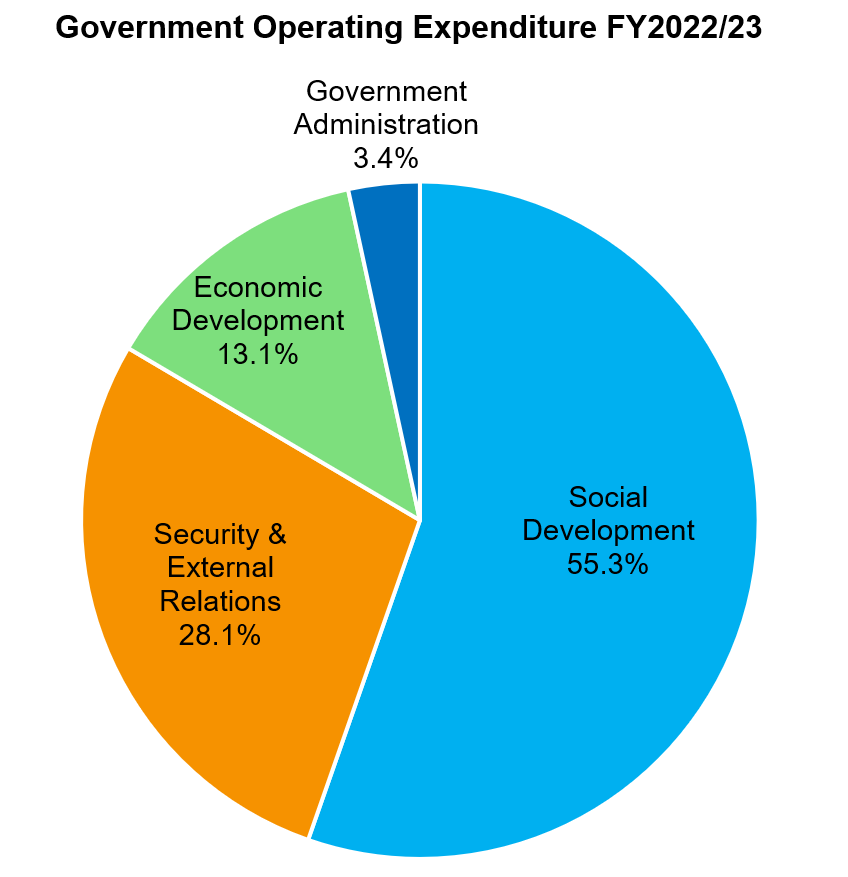The Singapore tax system
Taxes in Singapore support the government's spending to improve our community, environment, and economy. In the fiscal year 2022/23, most tax money (55.3%) goes to improving people's lives (Social Development). The next largest share (28.1%) is spent on areas such as Defence, Home Affairs, and Foreign Affairs (Security & External Relations). The rest (13.1% and 3.4%) is for growing the economy and government administration respectively.

Source: Economic Survey of Singapore, Second Quarter 2023
Fiscal policy
Fiscal policy in Singapore is how the government collects and uses revenue to impact the economy. The main goals are to:
- Encourage steady economic growth without causing inflation.
- Keep a balanced budget by funding expenses with revenue.
- Deliver essential public goods and services. For e.g., education, healthcare, infrastructure, housing, and programs to protect the environment.
These are based on market forces, prudence in spending, and focus on human and infrastructure investment.
Tax policy
Tax policy in Singapore serves two main purposes:
- Revenue Raising
Taxes are a key source of funding for government operations.
- Promotion of Economic and Social Goals
Taxes are used to influence behaviour for desirable goals. For e.g., encouraging businesses to adopt mechanisation and automation, and Singaporeans to have more children.
The key tenet of Singapore's tax policy is to keep tax rates competitive for businesses and individuals. This will attract foreign investment and encourage hard work and entrepreneurship.
To make tax revenue more resilient, the Goods & Services Tax (GST) was introduced in 1994. This balanced mix of income and consumption taxes strengthens Singapore's fiscal position against economic changes.
Government operating revenue
The main sources of government operating revenue are tax revenue, fees and charges, and other receipts. Tax revenue administered by IRAS accounts for 75.4% of the government operating revenue for the fiscal year 2022/23. This includes:
- Income Tax
Income tax is chargeable on the income of individuals and companies.
- Goods & Services Tax (GST)
GST is a tax on consumption. The tax is paid when money is spent on goods or services, including imports.
- Property Tax
Property tax is imposed on owners of properties based on the expected rental values of the properties.
- Stamp Duty
This is imposed on commercial and legal documents relating to stock & shares and immovable property.
- Gambling Duties
These are duties on betting, lotteries, sweepstakes, and gaming machines in any non-casino premises.
- Casino Tax
The casino tax is a tax levied on the casinos’ gross gaming revenue.
- Estate Duty (Removed for deaths occurring on or after 15 Feb 2008)
Estate duty is levied on the value of a deceased's net assets in excess of a threshold amount.
Other taxes imposed by the government and administered by other government agencies include:
- Customs, Excise, and Carbon Taxes
- Motor Vehicle Taxes
- Vehicle Quota Premiums
- Fees and Charges (Excluding Vehicle Quota Premiums)


